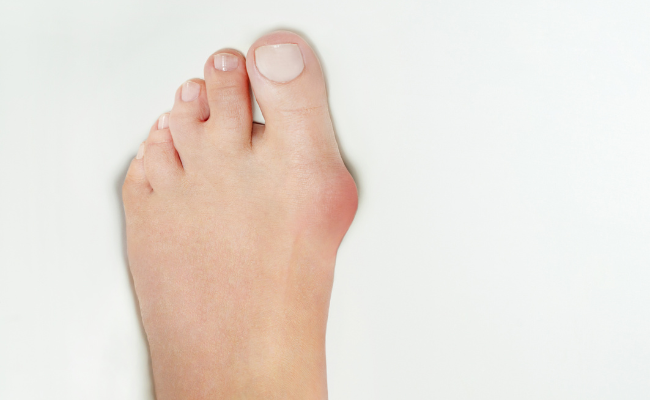How to Treat Bunions?
- December 13, 2023
- No Comments

What Are Bunions?
Bunions, known medically as "hallux valgus," manifest as bony bumps on the joint at the base of the big toe. This condition arises when the big toe exerts pressure against the adjacent toe, leading to the enlargement and protrusion of the joint, resulting in a visible bump on the side of the foot. This can cause pain, make finding comfortable footwear challenging, and potentially disrupt daily activities.
The emergence of a protruding bony bump at the base of the big toe, typically on the inner edge of the metatarsophalangeal (MTP) joint, characterizes a bunion. In such cases, seeking the guidance of a healthcare provider is advisable, especially when experiencing pain, stiffness, or numbness in the toes or feet. Consulting with a professional can facilitate the early identification and appropriate management of potential issues associated with bunions.
Why Do Bunions Develop?
Several factors contribute to the development of bunions. Genetics plays a significant role, as individuals with a family history of bunions are more likely to develop them. Wearing ill-fitting shoes, especially those with a narrow toe box or high heels, can also contribute to bunion formation. Additionally, certain foot conditions, such as flat feet or arthritis, can increase the risk of developing bunions. The gradual misalignment of the big toe joint often results from a combination of these factors.
How Can Bunions Be Treated?
- Footwear Modification: One of the initial steps in bunion treatment involves wearing comfortable and properly fitting shoes. Shoes with a wide toe box can help relieve pressure on the bunion and prevent further irritation. Avoiding high heels and shoes with pointed toes is crucial to reducing the progression of bunions.
- Orthotic Devices: Custom or over-the-counter orthotic devices can provide additional support and alignment for the foot. These devices help distribute pressure more evenly and can be beneficial in managing bunion-related pain.
- Toe Spacers and Splints: Toe spacers and splints can be used to help realign the toes and reduce pressure on the bunion. These devices are typically worn at night and aim to improve the overall alignment of the foot.
- Exercise and Stretching: Specific exercises and stretches can be recommended to strengthen the muscles around the affected joint and improve joint flexibility. Physical therapy may be beneficial in guiding individuals through a targeted exercise routine.
- Pain Management: Over-the-counter pain relievers, such as ibuprofen or acetaminophen, can be used to manage pain and inflammation associated with bunions. However, it's important to consult with a healthcare professional before starting any medication regimen.
Treatment Solutions for Severe Cases:
- Corticosteroid Injections: In cases where bunions cause significant pain and inflammation, corticosteroid injections may be administered. These injections help reduce swelling and alleviate discomfort, providing temporary relief.
- Customized Shoe Inserts: Custom-made shoe inserts, also known as orthotics, can be prescribed to address specific foot abnormalities and provide tailored support. These inserts aim to distribute pressure more evenly across the foot, reducing the impact on the bunion.
- Physical Therapy: Physical therapy can be beneficial for individuals with bunions, especially in severe cases. Therapists can guide patients through exercises that strengthen the muscles around the affected joint, improve flexibility, and enhance overall foot function.
- Surgical Intervention: When conservative treatments fail to provide relief, surgical intervention may be considered. Bunion surgery, also known as a bunionectomy, involves realigning the bones and tissues around the affected joint. Different surgical techniques exist, and the choice depends on the severity of the bunion and individual factors.
Benefits of Bunion Treatment:
- Pain Reduction: Effective bunion treatment can significantly reduce pain and discomfort associated with the condition. Addressing the underlying causes and implementing appropriate interventions can lead to improved quality of life.
- Improved Foot Function: Treatment methods, such as orthotic devices and exercises, aim to improve foot function and alignment. This can enhance mobility, balance, and overall comfort while walking or engaging in physical activities.
- Prevention of Further Complications: Timely intervention and appropriate treatment can prevent the progression of bunions and the development of secondary complications. This is particularly important for maintaining overall foot health.
- Enhanced Comfort in Footwear: As bunions are often aggravated by ill-fitting shoes, proper treatment allows individuals to find more comfortable footwear. This can be a significant relief for those who have struggled to find shoes that accommodate the bunion.
- Increased Mobility: Addressing bunions through a combination of non-invasive and, if necessary, surgical interventions can contribute to increased mobility. Individuals may experience improved range of motion and reduced limitations in their daily activities.
Comments (0)